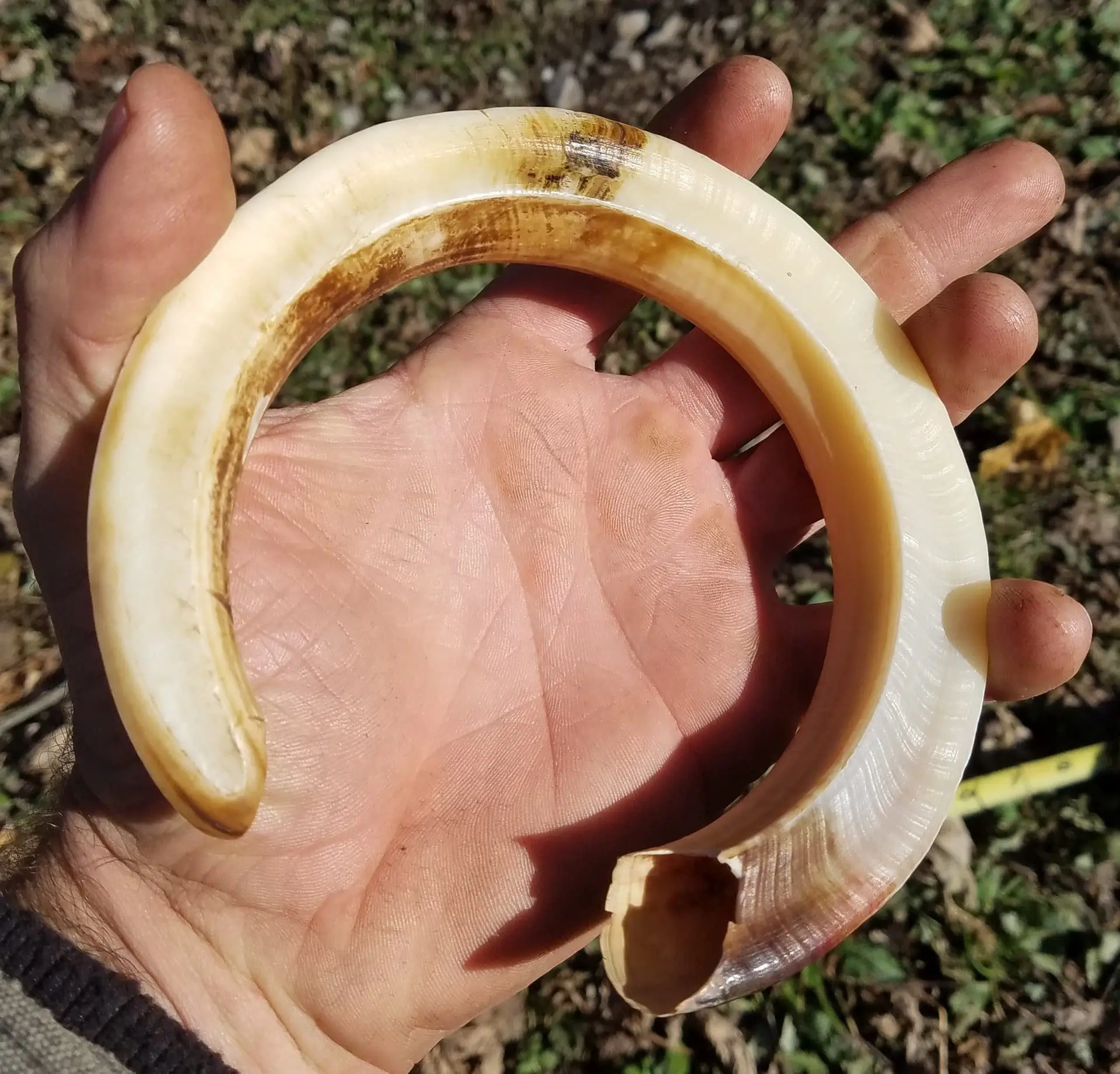Last December our big boar died and I buried him in a pile of hay bales to compost. Over the summer the pile broke down, so with a little sifting I was able to unearth the cleaned skeleton. I removed the tusks since they are so anatomically interesting.
Tusks (or tushes in some parts of the country) are the canine teeth of pigs. They are found on both the upper and lower jaw, with lower set tending to be larger and sharper along the outside edges. The upper tusks angle against the lower set to continuously sharpen them. All pigs have them, but males exhibit faster growth. The tusks of sows stop growing after a few years, but boars’ tusks continue to lengthen throughout their lives. The tooth on the right was broken off, probably 6-12 months before the boar died. In the wild, pigs periodically break off their teeth fighting with competitors and upstarts, so the ability to regrow tusks is important. This boar didn’t get into any fights (to my knowledge), but he could have broken the end off while digging up rocks and stumps.



I’m curious to see if I can cross-cut these tusks on my dad’s bandsaw or better yet on the tabletop scrollsaw for a fine kerf cut. With a little cleaning and polishing, these could make nice ivory disks for jewelry. Think of the marketing slogan “Boartooth ivory, the sustainable choice”. OK, so this is probably not ready for mass markets yet, but I’ve got to try it and see what happens. I am always drawn to objects crafted from materials native to a place and time. Stay tuned.

11 thoughts on “Boar Tusks”
Great little article here. Thanks for writing this. You write well.
Thanks Stewart!
Hello Dave my name ty, from CT. I am interested into wild boars tusk .. if to the future you are running tusk again will you let me know interest to buy, thank you
Hi Dave perozzi I’m interesting on your boar tusk would you like to sales me any broken tusk that were broken teeth away from the boar tusk. Thank you and I am looking forward to hear back from you. Sam 7033499387 or kingsamrit@gmail.com
Thanks for writing Sam. The tusks are no longer available, but I’ve got your contact info now in case I come up with some in the future.
Hahaha, I’ve just been talking to some folks about our boar who has just started growing his tusks (he is a year and a half old). Someone remarked he’d like to have the ivories! What do you do with the bones?
We let the bones lie in the ground. Occasionally we burn old bones in the wood stove and spread the ashes on the garden. I’ve read in a few old books that you can make a stinky tar paste out of burned bones and that it is an effective pest repellent for the garden. I’ve never tried it.
I’ve been thinking about this and found some use for the bones similar to what you mentioned, something done in Korean natural farming. I burn the bones and add them to coconut vinegar to make calcium phosphate for plants, I’m still testing how it goes…
Thanks, I read a few articles on that. It makes sense that the vinegar would be able to leach out some of the calcium. I really don’t have experience with foliar sprays (other than spraying diluted soap on tomato leaves to discourage pests), but it is an interesting topic. We have had blossom end rot on our tomatoes in the past. This would be addressed by eggshell and bone sprays. Since we’ve been able to apply more composted manure to the gardens over the last few years, a lot of the mineral deficiency problems have resolved themselves. But maybe we should look more into this topic.
Re cutting the teeth: A diamond saw would be best. See if you can get an abrasive blade or wheel.
I might give that a try. I do have a diamond saw for cutting tile. I’ve read that ivory cuts well with narrow-kerfed, small-toothed jeweler’s saws (basically a coping saw, but more delicate).